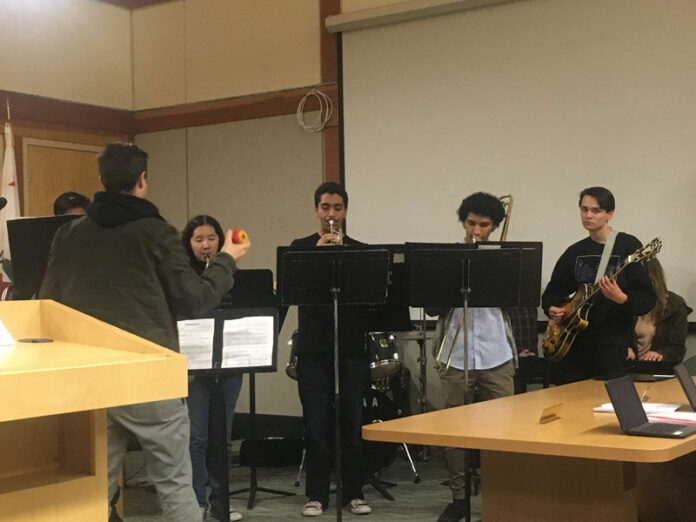
The first meeting of 2017 of the Healdsburg Unified School District Board of Trustees got of to a raucous start as the Healdsburg Junior High/High School Band opened the meeting with performance, led by teacher and bandleader John Natelli. The full house cheered at the music, which set the tone for a generally cheerful meeting.
“John came to us a couple of years ago and at the time all of his references called him a transformational teacher and it’s been true,” Healdsburg Junior High School Principal Bill Halliday said in his introduction. “We’ve seen our musical program grow in numbers and quality and it’s a tribute to him and what he brings to us. I find it amazing we have a band teacher who lists his musical influences as Sonic Youth and Bruce Springsteen.”
Much of the first meting was taken up with “red tape resolutions” — votes that must be taken to create the required legal trail of action to ratify and support Measure D, the $67 million bond passed by voters in November. The substance of the bond implementation plan is in a separate article that will be published tomorrow.
Recognition was given to the teachers and administrators of the new accelerated English program that has been implemented over the last four years. Director of Curriculum and Instruction Erin Fender called it “an extraordinary program that is changing the lives of our kids and is going to change the face of this community.” She gave credit — and certificates of achievement — to the teachers, site administrators and even Superintendent Chris Vanden Heuvel for their hard work in supporting and implementing the program.
Food services director Rosa Rubio gave the board an update on her plans and programs to provide fresh, homemade (not packaged) food items for kids at all levels, and additional information about the program at HUSD. Vanden Heuvel presented for approval a new sport at Healdsburg High School with the creation of a badminton team.
“We would be one of the last districts in Sonoma County to have a badminton team so it’s exciting to be a part of. It’s student driven; they approached a staff member and got sign ups and they have more than enough to have a team,” Vanden Heuvel reported.
Elementary school principals Stephanie Feith and Beth Wolk presented their experiences with a new assessment tool called STAR 360. Rather than reporting the data, the report covered how the tool works. The assessments, done on computers and taking only 20 minutes or so, provide immediate data to teachers and administrators about which students may need intervention, which students may need additional challenges and which students are doing just fine. Because of the short length of the test, students can take these assessments more frequently, allowing quicker interventions. In addition, the test is adaptive; if a student is struggling with a test above their proficiency level, the test will either time out and stop the test or alter the questions to a more appropriate level. This way, no child feels as though they “failed the test.”
STAR assessments in reading are given at the TK-fifth grade, with first through fifth grade also taking the math assessment. Some TK, K and first graders may be given an Early Literacy Assessment in lieu of the reading program, depending on their needs. Feith and Wolk stressed that this amount of data and reports which can be created using these assessments is enormous and can answer a lot of fundamental readiness and progress questions about students. They plan on returning at a meeting later in the spring to provide the board with some of the data being created by the STAR 2360 program.
The board approved the sale of surplus equipment, including a portable classroom being purchased by Sonoma Valley school district for $1. However, it was pointed out that removing/disposing of the portable could have cost the school district $20-30,000, so the savings of having another district pick it up was substantial.
Finally, the meeting drew to a close with a brief presentation by Director of Business Services Steve Barekman of the 2015-2016 audit report. In general, the number of items of concern were down from previous years, with continued challenges presented by so called ASB and site cash funds. These are monies collected and held on each campus for use by student activities and clubs. “They did say we had improved so that was encouraging,” said Barekman. “We’ve made substantial progress and I think we’ll make even more with our new district accountant, but I doubt we’ll ever achieve 100 percent as they have to have something to put in their report.”
Staffing pay and ratios were the root of the other two findings. “The first one is that we supposed to spend 55 percent of our general fund on salaries we spend 53.8 percent this year,” Barekman said. “We had a lot of one time expenditures for technology this year that just moved that denominator ever so slightly. We even gave our teachers a 3 percent raise and still came up a little short. But we can go to Sonoma County Office of Education and get a waiver and it’s taken care of.
“The other one has to do with the number of administrators we have,” Barekman continued. “The ratio says that for every x number of teachers you have, you should have one certificated administrator; under this formula we have too many administrators. I think if you polled the district however, you wouldn’t find anyone who thinks we’re overstaffed. I think a lot of districts our size can’t meet this requirement because it’s not realistic. If you’re LA Unified maybe, but not us. So we get dinged just as we did last year.”







